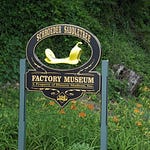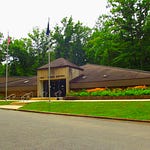Posey County, Indiana
This episode is the first of several podcasts about historic Posey County. Located on the extreme southwest corner of the state, Posey County was established by the Indiana Territorial Assembly November 1, 1814. The name derives from Indiana Territorial Governor Thomas Posey, who was governor at the time of its establishment.
From the Book
<iframe width="873" height="492" src="title="New Harmony Indiana" frameborder="0" allow="accelerometer; autoplay; clipboard-write; encrypted-media; gyroscope; picture-in-picture; web-share" referrerpolicy="strict-origin-when-cross-origin" allowfullscreen></iframe>
Visiting New Harmony Indiana
Posey County
Greetings, this episode is the first of several podcasts about historic Posey County. Located on the extreme southwest corner of the state, Posey County was established by the Indiana Territorial Assembly November 1, 1814. The name derives from Indiana Territorial Governor Thomas Posey, who was governor at the time of its establishment.
Before getting started, I would encourage you to subscribe to the Mossy Feet Books You Tube channel for more great content. If you like my videos, please hit the "Like," button. The more likes I get the more You Tube will show it to other people, allowing me to grow the channel. I also entreat you to visit my website, www.mossyfeetbooks.com. There you will find sample chapters, podcasts, a slew of content and links to where you can buy my books. While visiting the web site you can subscribe to it and receive email notifications of when I publish a new book or other content, like this video and podcast. This episode is based on my book, Southwest Indiana Road Trips.
County officials first met at the home Absalom Duckworth in the village of Blackford. They moved the county seat to Springfield in 1817. Mount Vernon became the county seat in 1825, where they constructed a small brick courthouse. The current courthouse was built in 1874. The three story Italianate style architecture building features red brickwork with details of Bedford limestone.
Historic New Harmony is located on the western border of the county on the shores of the Wabash River. New Harmony, Indiana has an interesting history. The town was the location for two social experiments led by idealists. George Rapp, along with several other men, traveled to the Indiana Territory in April 1814. They sought a new site for their community in Pennsylvania. The site the town now occupies caught their eyes. They decided it was an ideal place to establish a community as the Wabash is navigable and close to the Ohio River. They could easily access the markets of New Orleans with their goods. They would establish a community on the banks of the Wabash and thrive there for ten years. Then they sold the town to a second group and moved their congregation back to another site in Pennsylvania.
The second group, headed by idealist Robert Owen, purchased the town and used it to perform an experiment in socialism. During this time, the town became a leading center of science, especially the natural sciences
Vistors to New Harmony will want to begin their visit at the visitor center, the Athenaeum. Located on North Street, the Athenaeum sits on the north edge of the village overlooking the Wabash River. This should be for anyone visiting the town. The facility draws its name from the Greek temple of that name, dedicated to the goddess Athena. The building, funded by the Indianapolis Lilly Endowment, opened on October 10, 1979.
The Building
Designed by architect Richard Meier, the structure has won three major awards. These include:
American Institute of Architects
Twenty-five Year Award
Progressive Architecture Award
The building's design leads visitors through the building. It provides spacious views of the town and surrounding countryside as they progress through.
Visitors may view a seventeen-minute video in the 200-seat amphitheater. They may also sign up for a walking tour of the town, which departs from the building.
New Harmony History
Using exhibits, photos, drawings and models, the fascinating history of New Harmony unfolds. The most impressive exhibit in the building is a massive diorama of the town as it looked in its early history resides on the third floor.
All visits to New Harmony should begin here, at the Athenaeum. The informative, friendly staff will answer your questions and provide you with a tour schedule.
Note:
The Indiana State Museum operates the Atheneum Visitors Center as a State Historic Site.
The next several podcasts will cover many of the town's historic sites. These include:
Roofless Church
West Street Cabins
David Lenz House and Garden
Rapp-Owen Granary
Harmonist Cemetery
Harmonist Labyrinth
The Cathedral Labyrinth
Working Men's Institute
Harmonie State Park
The episode is based upon my book, South Central Indiana Road Trips, available on the web site, www.mossyfeetbooks.com. The book is the first book in the 9 volume Road Trip Indiana Series. The books include all the historical markers, as of 2022, in Indiana with the text and back story. The books also include a nearly complete listing of virtually every tourism destination in the state. The destinations include parks, museums, drive in theaters, bowling alleys, wineries and much, much more. I encourage you to visit the web site and subscribe to it.
You can find my books locally at the Walnut Street Variety Shop in Batesville, Indiana.
I hope you enjoyed this podcast and thank you for listening.













Share this post